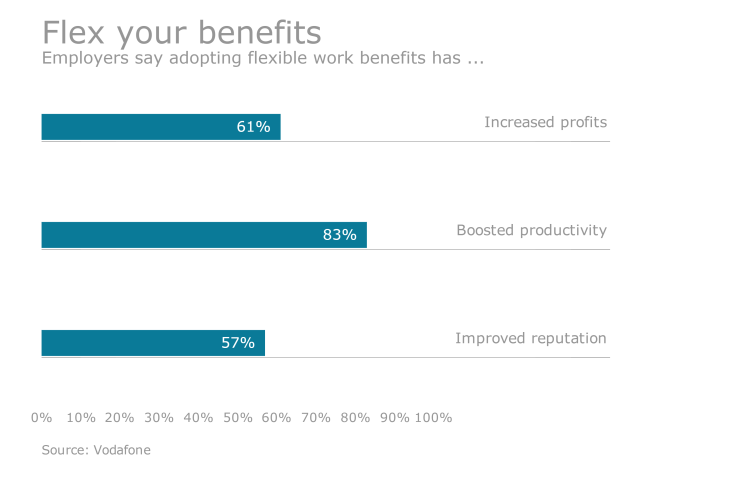Workplace flexibility, it seems, has finally hit the mainstream.
A new study, conducted on behalf of mobile network operator Vodafone, suggests rapid adoption of a benefit once considered fringe, with 75% of companies now having some kind of flexible workplace policy.
What’s more, Vodafone found, employers are very pleased with the results of allowing employees to work from home or vary their hours, citing soaring profits and more productive employees. Specifically, 61% of employer respondents said profits had increased, 83% said they had seen an improvement in productivity, and 57% said that adopting flexible working policies had been good for their external reputation.

Analysis was extensive: 8,000 global employers and employees were polled, and the survey drew on responses from small and medium-sized businesses, public sector organizations and multinational corporations in 10 countries.
The survey, says Jeni Mundy, product management director of Vodafone Group Enterprise, is “good news” for both employees and employers.
“Companies that embrace flexible working can expect an increase in profits, and around 50% of employees improve their work-life balance,” Mundy says.
This analysis comes on the heels of one last month from MIT Sloan School of Management and the University of Minnesota that looked at workers taking part in a workplace flexibility program at a Fortune 500 company. That report was unique because it was the first time a randomized controlled trial was used to measure the effects of workplace flexibility at a U.S. company. According to the analysis, the workers who participated in the workplace flexibility program were happier and less burned out than employees at the same company who chose not to participate.
The new research from Vodafone is important, says Vodafone Group Enterprise Chief Executive Nick Jeffery, because it represents that a “profound and rapid shift” is happening in the modern workplace.
Technological advances embraced by employers — cloud services, improved broadband and high-speed mobile networks, to name a few — are contributors to the rapid adoption of workplace flexibility, the research shows. And it will only continue, Vodafone predicts.
“Work is changing,” Mundy says. “It’s now seen as what you do, rather than where you go, and that trend is not going to slow down. Greater access to high-speed data services and more familiarity with technologies like cloud will only increase adoption of flexible working.”
Previous research has shown that flexibility is catching on and is a perk very much appreciated by employees. A survey of 1,000 employees by CareerArc last year, for example, found that three-quarters of employees said workplace flexibility was the most important benefit to them.
Still, there are barriers to adoption. There are still several stigmas attached to workplace flexibility, despite growing — and sometimes cautious — investment by employers.
“Companies that embrace flexible working can expect an increase in profits, and around 50% of employees improve their work-life balance.”
The 20% of employers who reported that they had no flexible work policy in place cited various reasons for their absence.
Of those businesses, 33% said they believed such a policy would not suit the culture of their organization; 30% were concerned about friction between employees working flexibly and those who did not do so; 25% believed that work would be unfairly distributed between flexible and non-flexible groups of employees; and 22% believed employees would not work as hard if allowed to adopt flexible working patterns and technologies.
Still, those companies acknowledged the potential benefits of adapting flex work, possibly pointing to future adoption of the perk. Of those companies with no flexible work policy, 55% said that employee morale would improve if they did introduce flexible working, 44% said they believed productivity would improve as a result; and 30% believed profits would increase.





